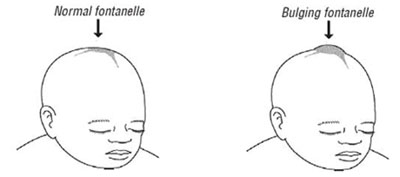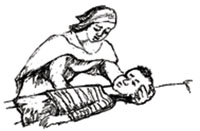3.4.2 Mode of transmission and clinical symptoms
Meningococcal meningitis is transmitted to a healthy person by airborne droplets from the nose and throat of infected people when they sneeze or cough. The disease is marked by the sudden onset of intense headache, fever, nausea, vomiting, sensitivity to light and stiffness of the neck. Other signs include lethargy (extreme lack of energy), coma (loss of consciousness), and convulsions (uncontrollable shaking, seizures). Box 3.2 summarises the general signs of meningitis, which may also be caused by some other serious conditions, and the more specific signs which are characteristic of meningitis.
Box 3.2 General and more specific signs of meningitis in infants
General signs of meningitis:
- Drowsy, lethargic or unconscious
- Reduced feeding
- Irritable
- High pitched cry.
More specific signs of meningitis:
- Convulsion (fits)
- Bulging fontanelle in infants.
![]() A child with typical signs of meningitis such as neck stiffness, bulging fontanelle and convulsion, should be immediately referred to the nearest hospital or health centre.
A child with typical signs of meningitis such as neck stiffness, bulging fontanelle and convulsion, should be immediately referred to the nearest hospital or health centre.
During examination of a baby with meningitis, you will notice stiffness of the neck, or bulging of the fontanelle – the soft spot on top of the head of infants (see Figure 3.4). The fontanelle bulges because the infection causes fluid to build up around the brain, raising the pressure inside the skull. A bulging fontanelle due to meningitis is observed in infants since the bones of the skull are not yet fused together.


Children may also show rigid posture due to irritation of the covering part of the brain or spinal cord. To check the presence of neck stiffness, ask the parents to lay the child in his/her back in the bed and try to flex the neck of the child (Figure 3.5).
If meningitis is not treated, mortality is 50% in children. This means that half of all cases end in death. However, with early treatment, mortality is reduced to between 5 to 10%. But about 10 to 15% of those surviving meningococcal meningitis will suffer from serious complications afterwards, including mental disorders, deafness and seizures.
3.4.1 Definition and cause of meningococcal meningitis
